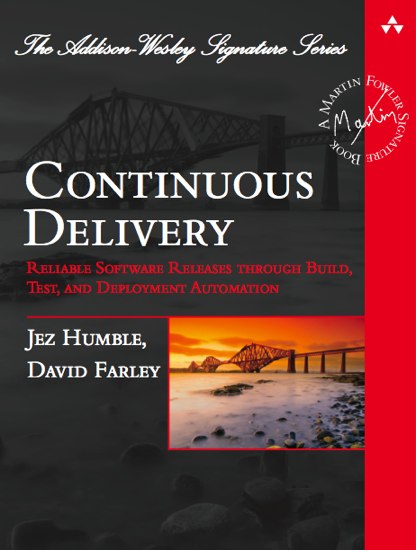
Continuous Delivery
I have reviewed many books on this website and I have gone through numerous others as part of my work on the Jolt Awards, but it’s been a very long time since I’ve read a book as useful and likely game-changing as Continuous Delivery.
The basic premise of the book is that we need to move past continuous integration into a fuller cycle of activities that go beyond build and test. Specifically, this new orientation calls for building and testing on all platforms, creating and deploying the final deliverables for all platforms—with every check-in. The benefit of this approach is that the development organization at any given moment always has: 1) immediate feedback on deployment issues, 2) a deployable binary; 3) a completely automated process to build, test, and deploy on all platforms.
This simple concept—a kind of continuous integration on mega steroids—has profound repercussions, all of which make your process better. The first and most important is that you have to automate everything downstream from the coding. And the authors mean everything. The most common point where people hem and haw about automation is deployment. But Humble and Farley make it clear you have to “bring that pain forward,” and fix the process so it can be automated. (If you don’t have any idea how you might refine and automate deployment, think virtualization. Can you emulate your current systems on virtual machines and then progressively simplify deployment of the software to the point of automation? Good, you’re on your way.)
But the mechanics of deployment may be the least of your challenges (And here, the book’s name could be viewed as misleading: Deployment is only one aspect it covers.) You also have to build, run, and test the software on every platform you ship on. You’re not reasonably going to be able to do that if you have to change configurations and manually reset values for different platforms. The authors guide you to finding the one path that gets you across the river Jordan without spending 40 years in the desert of bit twiddling. The key is to use a single codebase and move the platform dependent stuff into configuration files. This is non-trivial, but the authors offer plenty of good advice.
Testing is another topic Humble and Farley explore in great depth. Testing in the context of continuous delivery is not just running unit tests and a regression suite. No , this is running all tests—unit, integration, UAT, and so on. How to automate them effectively occupies probably the largest chunk of the book. Even if you don’t accept the continuous delivery concept, this section is worth the price of admission. It’s mind-expanding, in ways that the hundreds of articles we’ve all read about agile testing on Digg and Reddit never touch on. You see very quickly how much more automation you could do and how to get from your miserable semi-manual existence to the smooth flow of full and continuous automation.
What impresses about the book is how the authors consistently work through hard problems. They are not daunted by them and there is no attempt to pas over them with hand waving. Hard things are examined in detail with a perspective that derives from the authors’ own extensive experience.
I have literally never read a better book on process. I believe that going forward, this book will redefine agile process and CI; and it will have as much influence as--I have to go back to 1999, here--Fowler’s book on Refactoring did on code.
thank you --- excellent review/commentary --- will get a copy asap!
ReplyDelete